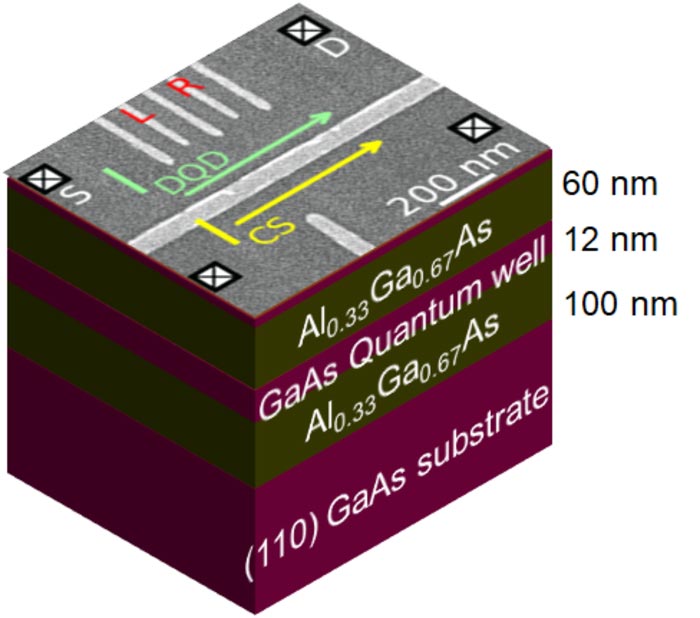New quantum dots for quantum networks

Schematic illustration of a double quantum dot (DQD) and charge sensors (CS) fabricated on (110) GaAs substrate
Credit: Tomohiro Nakagawa et al.
Researchers at Osaka University and National Research Council Canada develop new quantum dot circuits that have the potential to efficiently convert photon quantum information into electron spin, which may help advance the field of quantum networks.
Scientists from The Institute of Scientific and Industrial Research (SANKEN) at Osaka University, in collaboration with the Canadian National Research Council (NRC), developed a gallium arsenide (GaAs) quantum dot that can trap individual electrons. By controlling the crystallographic orientation of the substrate, the research team hopes to optimize the conversion of photons into spin-polarized electrons. This work may help make quantum networks more practical, especially for encrypting secure data.
Every computer or tablet you have owned is based on computations using the charge of electrons. While current electronic devices have achieved amazing feats of processing speed while becoming ever smaller, there is the possibility that manufacturers may someday soon come up on fundamental limits of what can be done using conventional methods. A promising alternative is to also use the intrinsic magnetic moment of electrons, called “spin.” Because these spins can be put into a superposition of both up and down simultaneously, it opens the way for quantum computers that may be able to solve certain problems much faster than current hardware. Spin can be also used as the medium for quantum communication by transferring quantum information with light. But this process of transferring information to the spin of extremely small electrons is challenging and has to be performed efficiently.
Now, a team of researchers led by Osaka University have realized the world’s first GaAs gate-controlled quantum dot circuit on a (110)-oriented surface that promises to increase photon-electron spin conversion efficiency (see Fig.1). This has the effect of encoding quantum information from incident photons into the electron spins. “We believe our research is the first demonstration of a gate-defined quantum dot circuit that also has charge detection capabilities, using this particular orientation of a GaAs substrate,” first author Tomohiro Nakagawa says.
Photon-electron spin conversion is performed by exciting an electron and a hole via absorption of a photon. While there are two types of holes, heavy and light, conventionally only light holes in GaAs quantum dot circuits on (001)-orientated surfaces have been used. Because of the way the hole interacts with the GaAs crystal lattice, the g-factor, which helps determine the magnetic moment resulting from the spin, can effectively be different in different cryptographic orientations. This feature allows for the efficient conversion of quantum information by using a heavy hole state, which used to be impossible for conventional substrates. In the future, this may be part of a protocol for sending uncrackable quantum secret keys for securing sensitive data. “One application of our work may be absolutely secure quantum cryptographic communication over long distances,” corresponding author Akira Oiwa says.
This work has been achieved as part of a strong international collaboration with NRC. “Bringing together complementary expertise, know-how, and facilities can greatly accelerate the pace of work towards the common goals of both groups, in this case, the development of quantum networks. International collaboration will be vital for the advancement of quantum network technologies over the coming decades,” says NRC Senior Research Officer David G. Austing.
The article, “Electron g-factor determined for quantum dot circuit fabricated from (110)-oriented GaAs quantum well” was published in Journal of Applied Physics at DOI: https://doi.org/10.1063/5.0086555
About Osaka University
Osaka University was founded in 1931 as one of the seven imperial universities of Japan and is now one of Japan’s leading comprehensive universities with a broad disciplinary spectrum. This strength is coupled with a singular drive for innovation that extends throughout the scientific process, from fundamental research to the creation of applied technology with positive economic impacts. Its commitment to innovation has been recognized in Japan and around the world, being named Japan’s most innovative university in 2015 (Reuters 2015 Top 100) and one of the most innovative institutions in the world in 2017 (Innovative Universities and the Nature Index Innovation 2017). Now, Osaka University is leveraging its role as a Designated National University Corporation selected by the Ministry of Education, Culture, Sports, Science and Technology to contribute to innovation for human welfare, sustainable development of society, and social transformation.
Website: https://resou.osaka-u.ac.jp/en
Journal: Journal of Applied Physics
DOI: 10.1063/5.0086555
Method of Research: Experimental study
Subject of Research: Not applicable
Article Title: Electron g-factor determined for quantum dot circuit fabricated from (110)-oriented GaAs quantum well
Article Publication Date: 6-Apr-2022
Media Contact
Saori Obayashi
Osaka University
gi-strategy@cgin.osaka-u.ac.jp
Office: 81-661-055-886
All latest news from the category: Physics and Astronomy
This area deals with the fundamental laws and building blocks of nature and how they interact, the properties and the behavior of matter, and research into space and time and their structures.
innovations-report provides in-depth reports and articles on subjects such as astrophysics, laser technologies, nuclear, quantum, particle and solid-state physics, nanotechnologies, planetary research and findings (Mars, Venus) and developments related to the Hubble Telescope.
Newest articles

Innovative 3D printed scaffolds offer new hope for bone healing
Researchers at the Institute for Bioengineering of Catalonia have developed novel 3D printed PLA-CaP scaffolds that promote blood vessel formation, ensuring better healing and regeneration of bone tissue. Bone is…

The surprising role of gut infection in Alzheimer’s disease
ASU- and Banner Alzheimer’s Institute-led study implicates link between a common virus and the disease, which travels from the gut to the brain and may be a target for antiviral…

Molecular gardening: New enzymes discovered for protein modification pruning
How deubiquitinases USP53 and USP54 cleave long polyubiquitin chains and how the former is linked to liver disease in children. Deubiquitinases (DUBs) are enzymes used by cells to trim protein…


